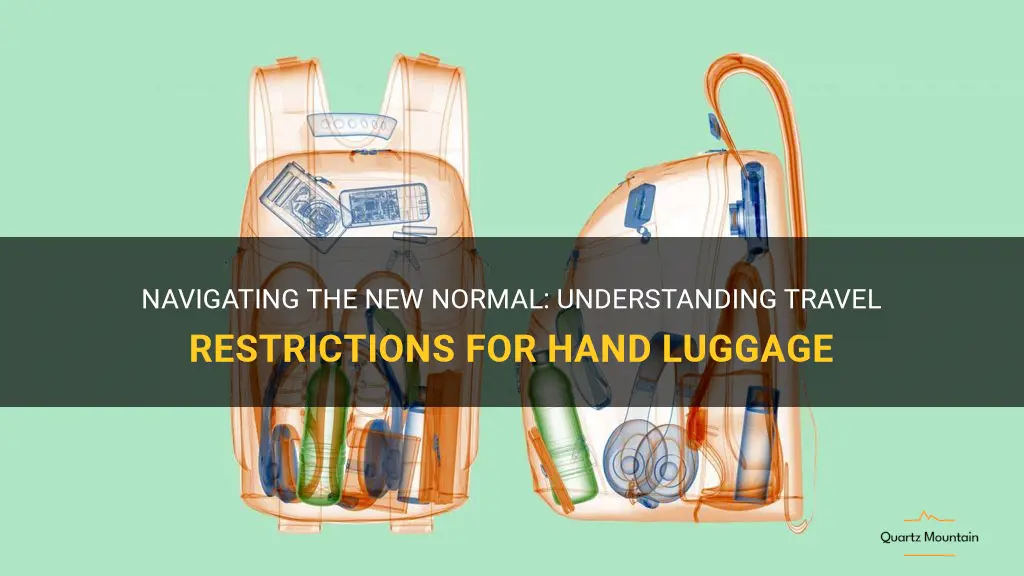
When it comes to travelling, one of the most important aspects to consider is the hand luggage restrictions. These restrictions vary from one airline to another, and can often be confusing to navigate. However, understanding and abiding by these restrictions is crucial to ensure a smooth and hassle-free travel experience. In this article, we will explore the ins and outs of travel restrictions on hand luggage, including what you can and cannot bring with you, as well as some helpful tips to make the process easier. So grab your bags and let's dive in!
What You'll Learn
- What are the current travel restrictions regarding hand luggage on airplanes?
- Can I bring liquids in my hand luggage, and if so, what are the restrictions?
- Are there any limitations on the size or weight of hand luggage for international flights?
- Are there any specific regulations for electronic devices in hand luggage?
- How strictly are the travel restrictions for hand luggage enforced at airport security checkpoints?

What are the current travel restrictions regarding hand luggage on airplanes?
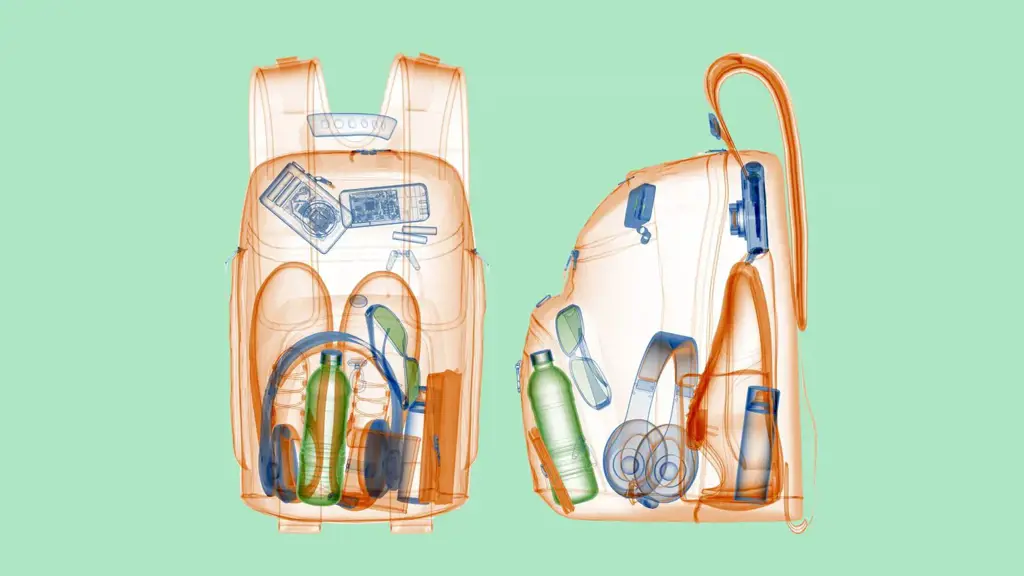
Hand luggage restrictions on airplanes vary depending on the airline and the country you are flying from. However, there are general rules and guidelines that are followed by most airlines to ensure the safety and security of passengers.
The size and weight restrictions for hand luggage can vary, but the most common limit is a maximum dimension of 22 x 14 x 9 inches and a weight limit of 15 pounds. This size limit generally allows for a standard-sized carry-on bag or a backpack to be brought on board. However, it is important to check with your specific airline and their website for their specific hand luggage restrictions, as they may have different size and weight limits.
In addition to size and weight restrictions, there are also restrictions on what can be brought in hand luggage. This is primarily to ensure the safety of all passengers on board. Liquids, gels, and aerosols are limited to containers that are 3.4 ounces or less, and all containers must be placed in a clear, quart-sized bag. This includes items such as shampoo, conditioner, toothpaste, and lotion. Medications and baby formula are generally allowed in larger quantities, but they may require additional screening at security.
Other restricted items include sharp objects such as knives, scissors, and razor blades. These items are generally prohibited from being brought in hand luggage and should be packed in checked luggage instead. It is important to carefully check the TSA or your airline's guidelines to ensure you are not bringing any prohibited items.
Electronics are generally allowed in hand luggage, but there may be additional screening requirements for larger devices such as laptops and tablets. It is always a good idea to check with your airline regarding any additional screening requirements for electronic devices.
It is important to note that these restrictions may vary depending on the country you are traveling from or to. Some countries may have stricter rules regarding hand luggage, while others may have more relaxed restrictions. It is always a good idea to check with your airline or the appropriate government agency for the most up-to-date information regarding hand luggage restrictions.
In summary, hand luggage restrictions on airplanes generally include size and weight limits, restrictions on liquids and sharp objects, and additional screening requirements for electronic devices. It is important to check with your specific airline and the appropriate government agency for the most accurate and up-to-date information regarding hand luggage restrictions.
Recent Travel Restrictions Between Australia and India: What You Need to Know
You may want to see also

Can I bring liquids in my hand luggage, and if so, what are the restrictions?
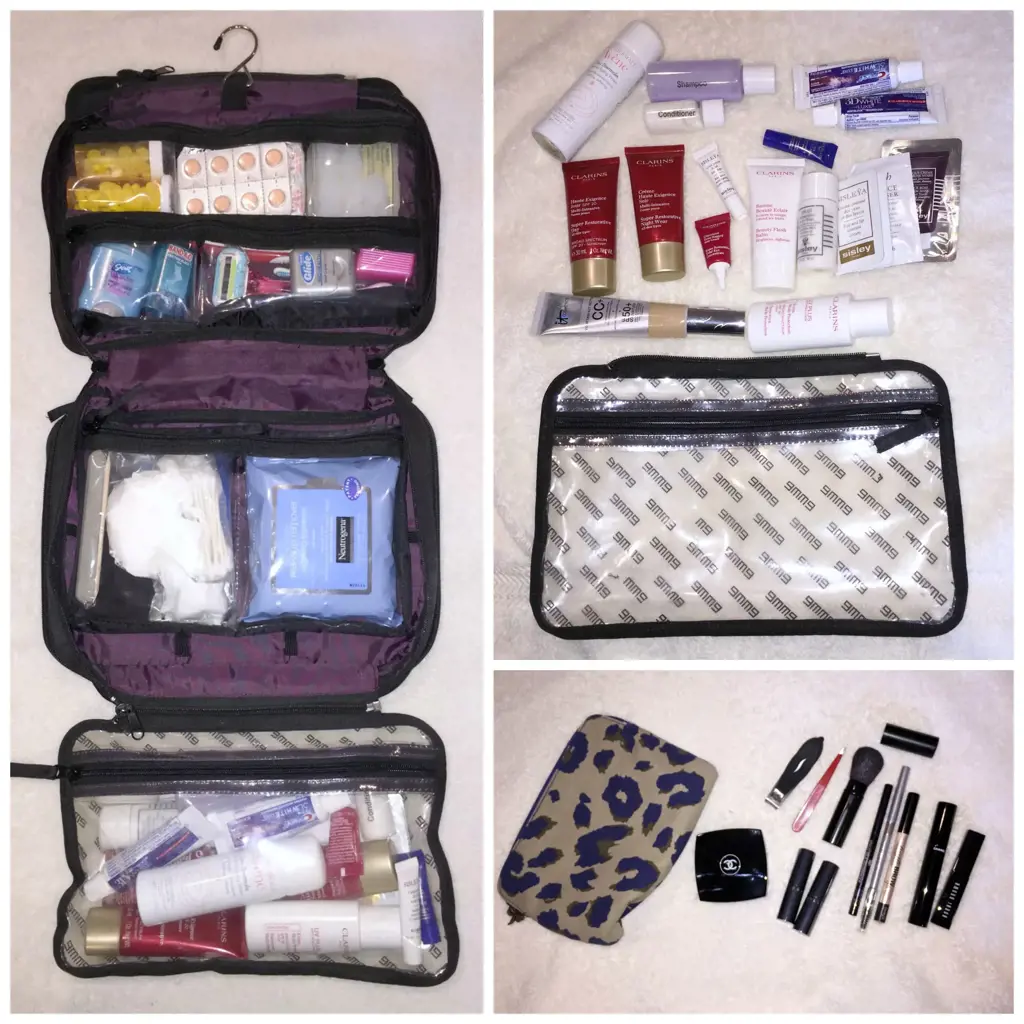
When it comes to traveling by plane, many people wonder about the rules and regulations surrounding liquids in hand luggage. Can you bring liquids in your carry-on bag, and if so, what are the restrictions?
The answer to this question is, yes, you can bring liquids in your hand luggage, but there are certain restrictions that you need to be aware of. These restrictions are in place for safety reasons, as liquids have the potential to be used as explosive substances.
The general rule for liquids in hand luggage is that they must be carried in containers with a maximum capacity of 100 milliliters (3.4 ounces). These containers must also be placed in a clear, resealable plastic bag with a maximum volume of one liter (approximately one quart). Each passenger is allowed to carry one plastic bag with their liquids.
It’s important to note that this limit applies to all liquids, including water, toothpaste, shampoo, and even alcohol. However, there are exceptions for certain items that are considered necessary for the duration of the flight, such as baby formula and medication. These items are allowed in larger quantities, but they may be subject to additional security checks.
When it comes to carrying liquids in your hand luggage, it’s important to follow these restrictions to avoid any issues at the airport security checkpoint. Failure to comply with the rules could result in your liquids being confiscated, or worse, you may be denied boarding.
To help you pack your liquids correctly, here’s a step-by-step guide:
- Check the volume of your containers: Make sure that each container is no larger than 100 milliliters (3.4 ounces). If any of your containers exceed this limit, you will need to transfer the liquid to a smaller container or leave it behind.
- Gather your liquids: Put all your liquids, including toiletries and cosmetics, in a clear, resealable plastic bag. Make sure the bag is no larger than one liter (approximately one quart).
- Seal the bag: Once all your liquids are in the plastic bag, seal it tightly. This will help prevent any leakage during the flight.
- Keep the bag easily accessible: When packing your hand luggage, make sure to place the bag of liquids in a location that is easily accessible. You will need to remove the bag from your luggage and place it separately in a tray for screening at the airport security checkpoint.
- Take note of exceptions: If you are traveling with baby formula, medication, or any other essential liquids, check the specific rules for these items. They may be allowed in larger quantities or may require additional documentation.
- Be prepared for security checks: Be aware that your bag of liquids will be subject to additional security checks. This may include X-ray screening or manual inspection. Cooperate with the security officers and be prepared to answer any questions they may have.
By following these steps and understanding the restrictions, you can ensure a smooth and hassle-free experience when traveling with liquids in your hand luggage. Remember to double-check the rules before you travel, as they may vary depending on the airline and destination. Safe travels!
Understanding the Alamo Rental Car Travel Restrictions: What You Need to Know
You may want to see also

Are there any limitations on the size or weight of hand luggage for international flights?
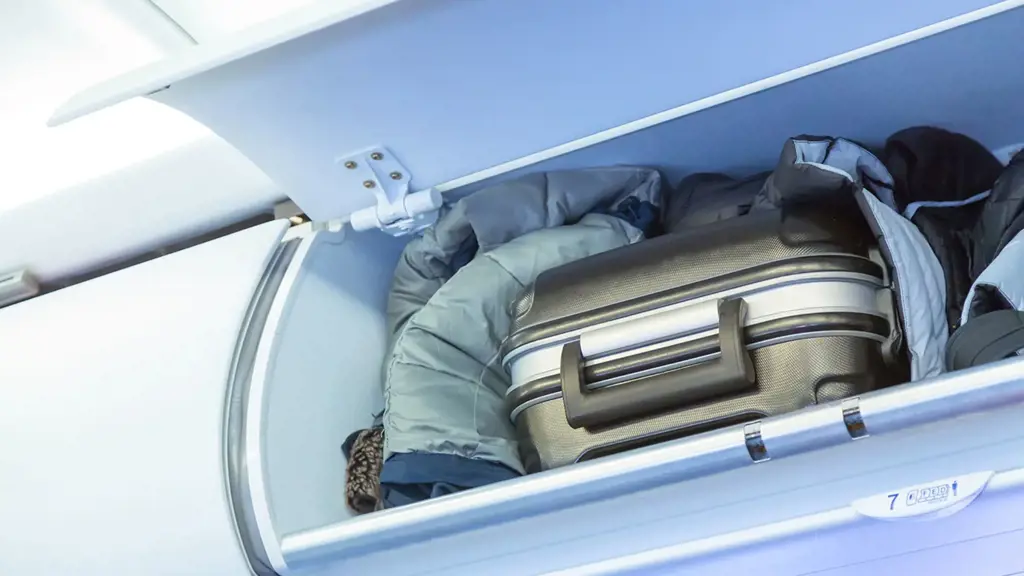
When it comes to air travel, there are various rules and regulations that passengers need to adhere to. One such concern for many travelers is the limitations on the size and weight of hand luggage for international flights. In order to ensure a smooth and efficient boarding process, airlines impose certain restrictions on what passengers can carry on board.
The International Air Transport Association (IATA) has set guidelines for hand luggage dimensions and weight, but it's important to note that each airline may have its own specific regulations. Generally, the dimensions of hand luggage should not exceed 56cm x 45cm x 25cm (22in x 18in x 10in), including handles and wheels. This is because the overhead compartments and under-seat storage areas on planes have limited space, and exceeding these dimensions may result in difficulties in stowing the luggage. In addition to the size restrictions, there are also weight limitations, typically ranging from 7kg to 12kg (15lbs to 26lbs) depending on the airline.
The reasons for these limitations are primarily related to the safety and comfort of passengers. Airlines want to ensure that there is enough space in the overhead compartments for all passengers' hand luggage, as well as to prevent any potential injuries caused by falling objects. Furthermore, weight restrictions are in place to prevent overloading of the aircraft, as excess weight can affect fuel efficiency and overall safety.
To avoid any issues at the airport, it is crucial for passengers to familiarize themselves with the hand luggage policies of the airline they are flying with. This can usually be found on the airline's website or by contacting their customer service. Some airlines may also offer different baggage allowances based on the class of service, frequent flyer status, or destination.
In addition to size and weight restrictions, there are also certain items that are prohibited from being carried in hand luggage. These include sharp objects, firearms, flammable substances, and liquids in containers larger than 100ml (3.4oz). These restrictions are put in place to ensure the safety of all passengers and comply with international security regulations.
It's worth noting that airlines may enforce these regulations differently, especially when it comes to hand luggage weight. Some airlines are more strict and may weigh the bags at the check-in counter or at the gate, while others may rely on the passengers' honesty and compliance with the rules. However, it's always recommended to adhere to the stated limitations to avoid any inconvenience or additional charges.
To maximize the space and weight allowance for hand luggage, travelers should consider packing efficiently. Rolling clothes instead of folding them can save space, and using packing cubes or compression bags can compress items to make them fit better. Another tip is to wear the heaviest or bulkiest items, such as coats or boots, to avoid adding unnecessary weight to the hand luggage.
In conclusion, there are indeed limitations on the size and weight of hand luggage for international flights. Passengers should familiarize themselves with the specific policies of the airline they are traveling with to ensure compliance and avoid any issues at the airport. By adhering to these regulations and packing efficiently, travelers can make their journey more convenient and enjoyable.
Navigating Medication Restrictions for Travel to Singapore
You may want to see also

Are there any specific regulations for electronic devices in hand luggage?
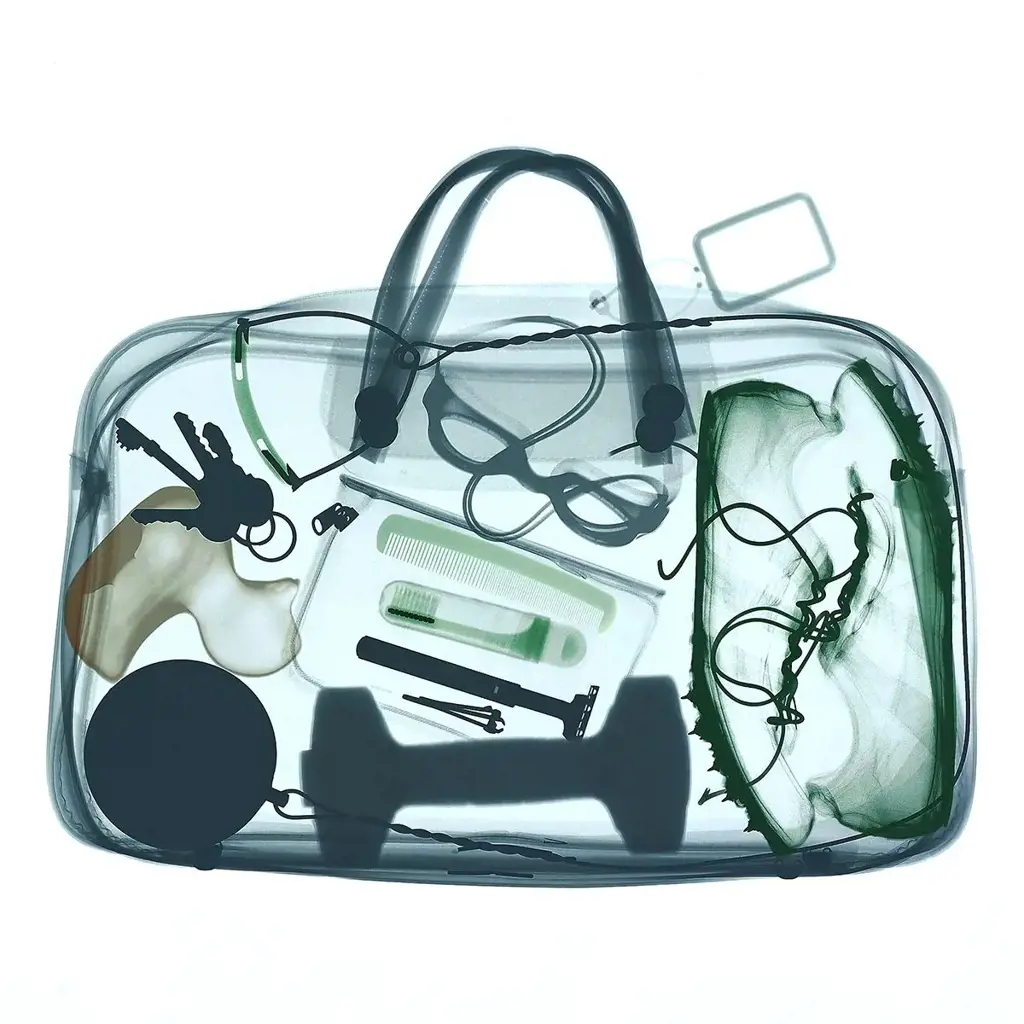
In today's modern world, electronic devices have become an essential part of our daily lives. When it comes to air travel, it is important to know the regulations and guidelines regarding carrying electronic devices in hand luggage. This article will explore the specific regulations and restrictions in place for electronic devices in hand luggage.
Firstly, it is important to note that different countries and airlines may have varying regulations for electronic devices in hand luggage. However, there are some common guidelines that are followed by most airlines worldwide.
One of the key regulations regarding electronic devices in hand luggage is the size and weight limit. Most airlines have restrictions on the overall dimensions and weight of hand luggage, which includes electronic devices. These restrictions are in place to ensure that the overhead compartments and under-seat storage areas are not overloaded and can accommodate the luggage of all passengers.
For example, many airlines have a maximum dimension limit of 55 cm x 35 cm x 25 cm (including wheels and handles) for hand luggage. This means that any electronic device, such as a laptop or tablet, must fit within these dimensions to be considered as acceptable hand luggage.
Another important regulation is regarding the battery capacity and its packaging. Lithium-ion batteries, which are commonly found in electronic devices, have specific restrictions due to their fire risk. It is generally required that any spare or loose lithium-ion batteries must be individually protected to prevent short circuits. This can be done by covering the battery terminals with electrical tape or placing them in a separate plastic bag.
In addition, some airlines may have restrictions on the number of spare batteries that can be carried in hand luggage. It is recommended to check with the airline beforehand to ensure compliance with their regulations.
Furthermore, when going through airport security, passengers are required to separate their electronic devices from their hand luggage and place them in a separate tray for screening. This is done to ensure that security personnel can get a clear view of the electronic devices without any obstruction.
It is important to note that these regulations are primarily in place for security and safety reasons. The restrictions on size, weight, and battery packaging help to ensure that the aircraft remains safe during the flight. These regulations also help to streamline the boarding process and make it easier for passengers to manage their hand luggage.
In conclusion, there are specific regulations for electronic devices in hand luggage when it comes to air travel. These regulations primarily focus on the size, weight, battery capacity, and packaging of the devices. It is essential to check with the airline beforehand to be aware of any specific regulations they may have. By following these guidelines, passengers can ensure a smooth and hassle-free journey with their electronic devices in hand luggage.
Understanding Eva Airways Travel Restrictions: What You Need to Know
You may want to see also

How strictly are the travel restrictions for hand luggage enforced at airport security checkpoints?
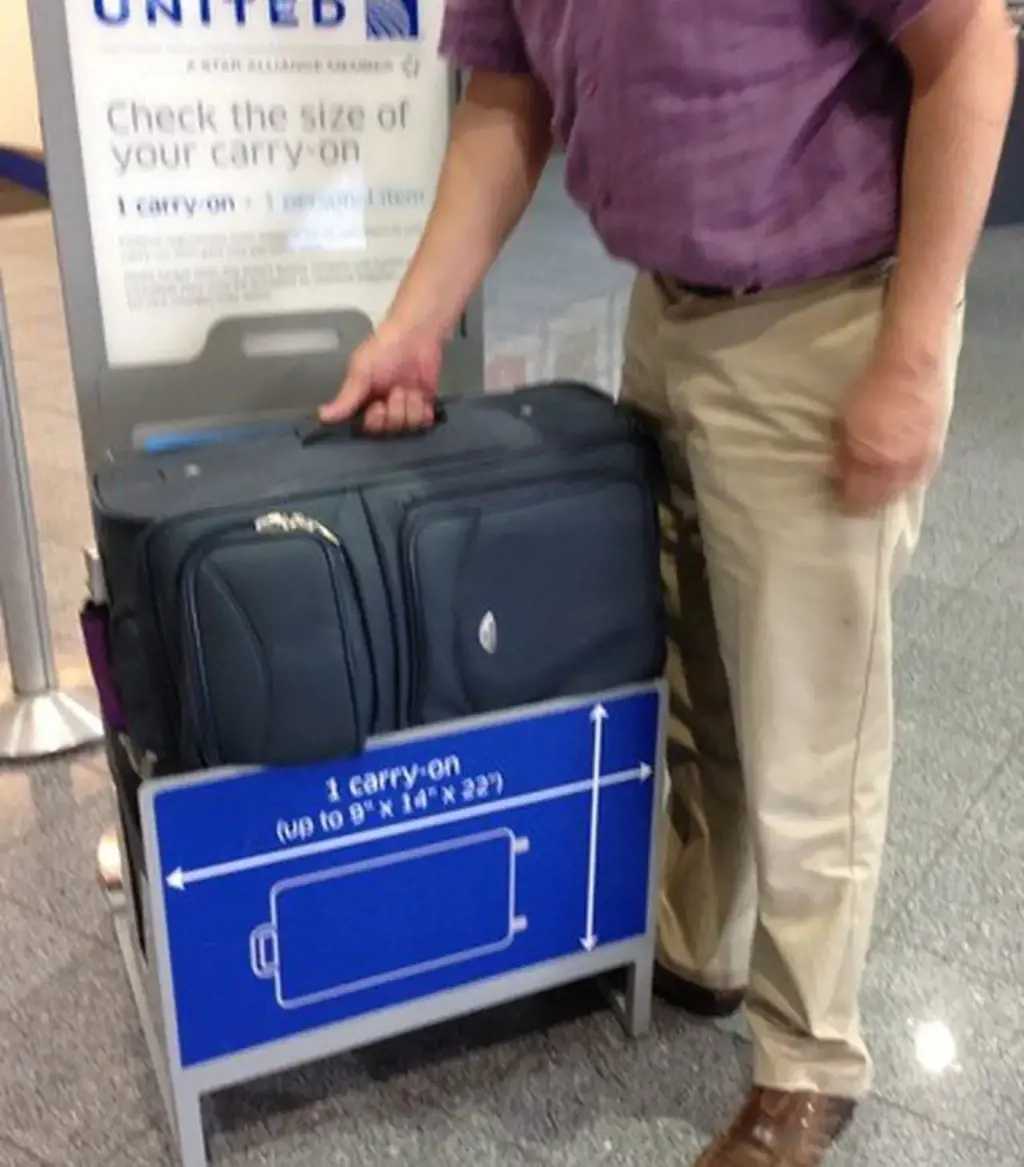
Travel restrictions for hand luggage enforced at airport security checkpoints are generally strictly enforced to ensure the safety and security of all passengers. These restrictions are put in place to prevent any potential threat or danger in the aircraft cabin. Security personnel at airports have specific guidelines and procedures they follow to ensure that all passengers comply with these restrictions.
The Transportation Security Administration (TSA) in the United States, for example, has strict rules regarding the size and contents of hand luggage. Passengers are limited to one carry-on bag and one personal item, such as a purse or laptop bag. The carry-on bag should not exceed the maximum dimensions specified by the airline, typically around 22 inches long, 14 inches wide, and 9 inches tall. Any bag larger than these dimensions will be required to be checked in as hold luggage.
In addition to size restrictions, there are also restrictions on certain items that can be brought in hand luggage. Liquids, gels, and aerosols must be in containers of 3.4 ounces (100 milliliters) or less and must be placed in a clear, plastic, quart-sized bag. These items include toiletries, such as toothpaste, shampoo, and perfume. Any item that is not compliant with these restrictions will be confiscated by security personnel.
At airport security checkpoints, passengers are required to remove their electronic devices, such as laptops and tablets, from their bags and place them in separate trays for X-ray screening. Outerwear, such as jackets and coats, must also be placed in a separate tray. All bags and personal belongings are subjected to X-ray screening to ensure that there are no prohibited items or potential threats.
Passengers may also be subjected to additional screening, such as a pat-down or a hand swab, if the X-ray operator detects anything suspicious. This is done to ensure that there are no concealed weapons or dangerous substances being brought onto the aircraft.
Overall, airport security personnel are trained to be thorough and vigilant when enforcing travel restrictions for hand luggage. While the level of strictness may vary between airports and countries, it is important for passengers to be knowledgeable about these restrictions and be prepared to comply with them to avoid any unnecessary delays or issues at security checkpoints.
In conclusion, travel restrictions for hand luggage at airport security checkpoints are strictly enforced to ensure the safety and security of all passengers. It is important for passengers to be aware of these restrictions and comply with them to avoid any potential issues or delays. By following the guidelines and procedures set by the relevant authorities, passengers can help ensure a smooth and efficient screening process at the airport.
Nazi Restrictions on Jewish Travel: A Dark Chapter in History
You may want to see also
Frequently asked questions
The travel restrictions for hand luggage can vary depending on the airline and destination. However, there are some common restrictions that are usually enforced. These include the size and weight limits for carry-on bags, the prohibition of certain items such as liquids over 3.4 ounces, and the requirement to remove laptops and other electronic devices for separate screening at security checkpoints.
Many airlines allow passengers to bring a small personal item, such as a purse or laptop bag, in addition to their carry-on bag. However, there are usually size and weight restrictions for personal items as well. It's important to check with your specific airline to determine their policies regarding personal items.
The Transportation Security Administration (TSA) has strict rules regarding liquids in hand luggage. In general, liquids must be in containers that are no larger than 3.4 ounces and all containers must be placed in a single, clear, quart-sized plastic bag. Each passenger is limited to one quart-sized bag of liquids. It's important to note that there are exceptions for certain necessary liquids, such as medications or baby formula, but these must be declared at the security checkpoint and may be subject to additional screening.







